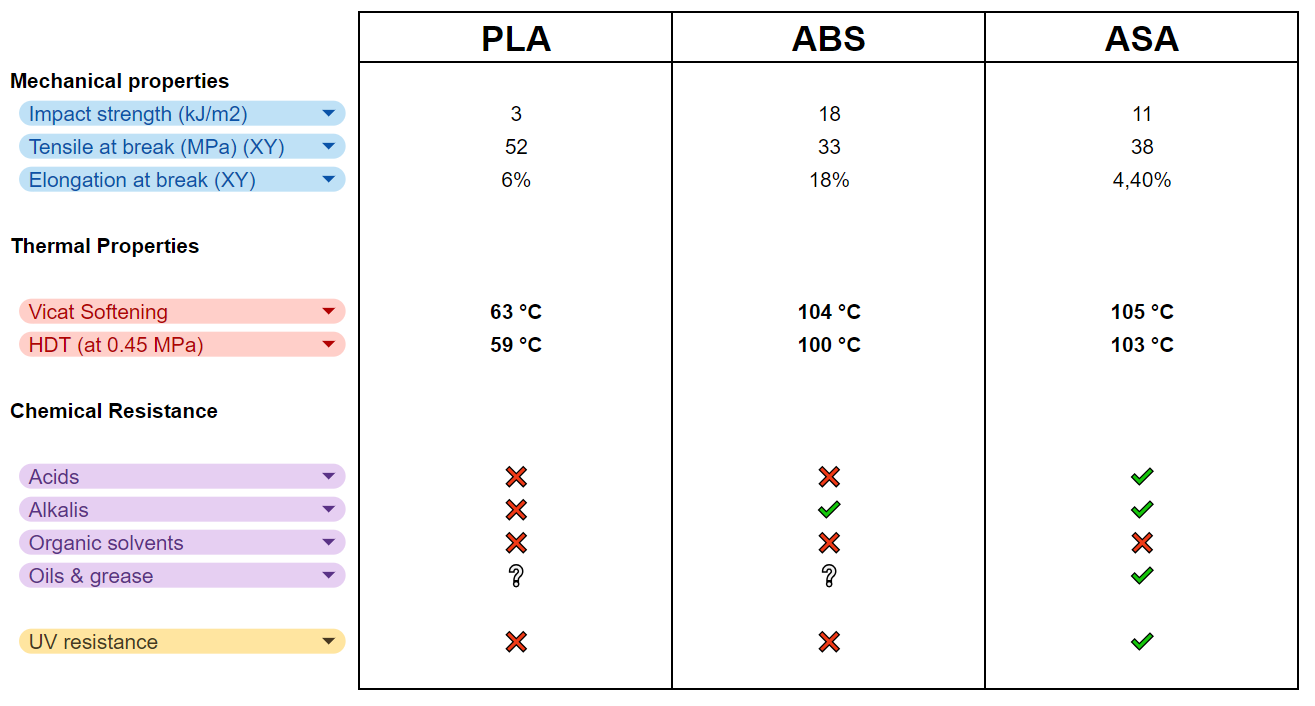With 3d printing becoming more and mode mainstream, we’re seeing 3d printed replica components appear on various sites and forums. An interesting evolution for parts that become rare such as side panels for our little Honda bikes.
I do think it’s important to know what you’re buying, because all printed parts are not the same. Unfortunately, printed parts are sometimes offered without disclosing what they are made of, or in materials that are simply not suitable for their purpose…
Especially when a part requires labor-intensive post-processing (e.g. a sidepanel that needs sanding and painting) you should make sure the part is worth the effort, and will hold up over time. You wouldn’t want your painstakingly prepared side panels to melt on your first summer ride..
This is why I print sidecovers in ASA and not in PLA. Find more technical info below
Qualities requirements
Impact Resistance
the part should be able to resist knocks and bumps.
Weather Resistance
The part should be able to withstand long exposure to sunlight, rain, and other weather conditions without deterioration, fading, or cracking over time.
Temperature Resistance
The parts should remain stable with significant temperature variations, from scorching engine heat and summer sunlight to chilly nights.
Chemical Resistance
being able to withstand corrosion from contact with fuels, oils, and other chemicals is also essential
Considerations for Production
Material Cost
While quality is paramount, affordability is also a significant consideration to ensure cost-effective production without compromising performance.
Ease of Printing
Some materials are easier to print than others. If a material is harder to work with, prints will fail more often, and the cost per successful print will increase substantially. Typical cause of failure for larger prints are:
- Poor bed adhesion, causing objects to release from the build plate, or support structures that fail.
- Poor layer adhesion
- Warping / deformation during printing
Toxic fumes
High end plactics release toxic fumes during printing.
PLA
Polylactic Acid
PLA is the most commonly used filament for hobby-grade FDM 3D printing. It claims to be an environmentally friendly, biodegradable and recyclable plastic. Here’s why it’s so popular:
- It is fairly cheap and comes in a huge array of brands and colors.
- Very easy to print. You can make large parts without worrying about warping
- Can be used on any printer, no need for heated bed or enclosure
- No smelly fumes during printing
However, PLA is fairly basic when it comes to technical qualities, which is why I would NOT recommend it for end-use motorbike parts:
- low impact resistance
- Low temperature resistace, will deform between 50-60 degrees C
- low weather resistance (‘biodegradable’)
- low chemical resistance
- bonus: it’s a total bitch to sand in shape
So PLA is great for gadgets, or mockup models, or generally to print heaps of garbage in good conscience. BUT not what you need for a motorbike part that should last for years
ABS
Acrylonitrile Butadiene Styrene
ABS is a classic technical material. I’s fairly cheap and is available in a wide range of brands and colors. The technical qualities are superior to PLA:
- Better impact resistance
- Moderate weather resistance
- Higher temperature resistance
- Adequate chemical resistance
Downsides of ABS:
- Warps easily during printing, so higher failure rate
- Much harder to get good bed adhesion and layer adhesion
- Needs a heated / enclosed printer
- Releases toxic fumes during printing
So ABS is better, but generally more difficult and expensive to work with compared to PLA
ASA
Acrylonitrile Styrene Acrylate
Asa is becoming the go-to material to replace for ABS in 3d printed applications. This is due to its improved UV resistance and lower shrinkage during printing.
- high impact resistance
- Excellent weather resistance and resistant to UV radiation, so better suited for prolonged outdoor exposure
- Far better Temperature resistance
- Higher chemical resistance compared to ABS, resistant to fuels and oils
Drawbacks
- Despite better warp-resistance compared to ABS, you still need a fine-tuned machine to successfully print large parts
- Can be difficult to get proper bed-adhesion and layer adhesion, resulting in higher failure rate. Printing at higher temperatures and lower speeds gets better results
- Needs an enclosed printer
- Toxic fumes when printing
- Higher material cost compared to PLA and ABS, on top of lower printing speed and higher failure rate, makes it more expensive to work with.
–> Despite being more expensive to use, ASA is my primary choice for end-use parts.
